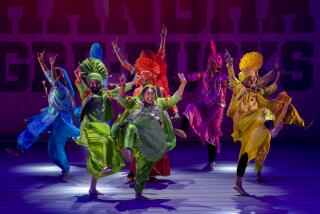Dance : Birju Maharaj Offers Kathak
- Share via
Sharing the stage of La Mirada Civic Theatre with five musicians, Birju Maharaj dances the culminating episode of the ancient Hindu epic “Ramayana” in a composition by his grandfather.
Emphasizing the heroic scale of the characters and the terror of the final battle, he whirls from one role to another--in an instant transforming himself from the avenging archer to the proud victim (just a flash of pain) and the grieving widow.
Maharaj is one of the greatest dance stars in India, the head of a dynasty of masters. However, at this moment in his Friday program, he takes the classical art of Kathak dance back to its origins, when itinerant storytellers (kathakars) performed in North Indian temples.
The remarkable intimacy, expressive detail and technical brilliance Maharaj achieves here also distinguish his own contemporary solo pieces, reaching a special level of excitement when he focuses on interaction with the tabla (hand-drum) virtuosity of Zakir Hussain in complex rhythmic cycles featuring sudden-death terminations.
Their inspired collaboration remains unsurpassed in the 3 1/2-hour performance, partly because the experience of solo Kathak isn’t transferable to a narrative group piece such as Maharaj’s “Parvati Parinaya,” which uses Kathak technique in a literal, linear 20th-Century dance-drama format.
Here Jai Kishan Maharaj as Shiva and Saswati Sen as Parvati must freeze until it’s their turn to dance--while some of us wonder why a single dancer couldn’t play both roles. Where’s a kathakar when you really need one?
Depicting the passing of the seasons as well as the love of the gods, the piece offers transitional corps sequences of great fluidity and one sensational bravura passage of whiplash turns-in-place by Krishan Mohan Misra. But Sen’s exceptional acting abilities and technical refinement find much more persuasive showcases elsewhere on the program.
More to Read
The biggest entertainment stories
Get our big stories about Hollywood, film, television, music, arts, culture and more right in your inbox as soon as they publish.
You may occasionally receive promotional content from the Los Angeles Times.









